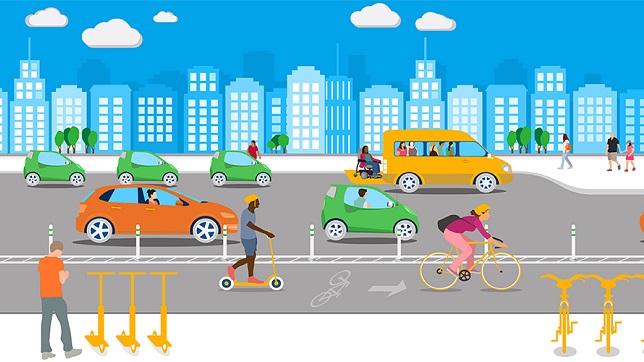Shared Mobility

Abstract
The exponential growth in population in major cities across the globe has put a tremendous amount of strain on the existing infrastructure. The pace of development cannot keep up with the unprecedented urbanization. Most major cities face traffic stalls daily. The increasing number of vehicles also require a lot of fuel which is simply not sustainable. It is the need of the hour to make the transport system more efficient rather than bulky. Shared mobility is a step in that direction. In this paper, we analyze different types of shared mobility, the challenges, and how we can adapt to them.
Introduction
The popularity of shared mobility has accelerated in the past decade, but it’s been around for quite a long time. The first carsharing company started in Zurich, Switzerland in 1948, and the first bike-sharing establishment was started in 1965 in Amsterdam, Netherlands. Shared mobility becomes an effective means to commute sustainably. The development of infrastructure, science, and technology so far was made in a manner to make human lives better but now development needs to take a different arc of sustainability. Shared mobility allows us to effectively use the current infrastructure. Metropolitan cities with a lot of traffic problems can benefit heavily.
The most known forms of shared mobility are carsharing and bike-sharing, but it also includes public transport, ridesharing, micro-transit, and many more. Shared mobility opens a range of different mobility options to explore. Popular TNC Companies like Uber and Lyft have tried to commercialize certain modes of shared mobility like ride-splitting which allows the users to travel more economically. Since the objective of shared mobility is Sustainability, it paves the path for popularizing new modes of transport like e-vehicles, micro transits, and even Sky trains. To ensure shared mobility also reduces the commute time, faster public transport systems will come up. As the popularity of shared mobility increases, it will slowly become the norm. Cities like Vancouver and Helsinki have pioneered and established the success of shared mobility. Helsinki has managed to reduce its carbon dioxide emissions by 34 percent, reduce congestions by 37 percent and increase rail/metro ridership between 15 percent to 23 percent.[3]
Different modes of Shared Mobility
Any form of the communal transport system can be considered a type of shared mobility. These include buses, trains, metro, trams, etc. But these forms of transport require a lot of investment and they cannot provide last-mile connectivity to everyone. Even those who are actively using the public transport system must rely on vehicles like cars and bikes for getting access to the system. This leads to there being a need for large parking spaces near metro stations, and bus stands. The limited size of the parking space force commuters to use privately owned vehicles for end-to-end connectivity. Given that there are more than 1.4 billion cars in the world, Shared mobility is focusing on utilizing these privately owned vehicles to provide enhanced and comfortable connectivity.
The different types of shared mobility considered in this paper are:
Carsharing: Renters can borrow a vehicle for a short amount of time.
Roundtrip carsharing: Renter picks up and returns the vehicle to the same point.
Point-to-point Carsharing: Renter picks up the car at one point and drops it at his/her destination
Peer-to-peer carsharing: Owner can enroll their vehicle in carsharing programs.
Niche carsharing services: Closed network car sharing for apartments, colleges, etc.
Ride sourcing: Certain companies connect commuters with private vehicle owners for renting the vehicle.
Ride-Sharing: It involves adding extra riders to pre-existing trips who might be travelling along the same way.
Carpooling: – A formal or informal arrangement between commuters to share vehicles to save on fuel.
Vanpooling: – A larger form of carpooling often used by employees of a company or by schools.
Real-time or dynamic ridesharing: Online applications which add extra commuters who are travelling along the same path to an ongoing ride.
Existing Challenges
Shared mobility has a lot of promising benefits but also has its fair share of challenges. Shared mobility will require people to rethink the way they view travel. The best mode of travel is determined by three parameters: cost, convenience, and commute time. Shared mobility currently faces the issue of addressing these three parameters effectively. Walking is an essential part of shared mobility. Most developing cities are not pedestrian-friendly. They lack the infrastructure to provide pedestrian safety. Safety and security are major concerns when it comes to shared mobility. The common security concerns are pickpocket crimes, thievery, rash driving, or an uncanny encounter with a person brewing ill intentions. In-vehicle sharing, oftentimes the vehicle is not in the right condition and that may lead to unfortunate accidents.
Shared mobility is a relatively new terminology that has been gaining importance recently. Due to the newness, people are still not accustomed to the idea. Countries need to update the transport policies to accommodate new modes of transport. Owning a vehicle for individual transport needs has been the norm for quite some time. Apart from cities with excellent public transport connectivity, most cities don’t practice shared mobility. In certain countries, it’s seen as a status symbol to own a car. Also having an independent mode of transport allows a degree of freedom that is not possible in shared mobility. Oftentimes people prefer to use a single mode of transport to reach a destination. Shared mobility requires people’s willingness to adapt to the multi-mode of transport.
Although there are multiple modes of shared mobility, there is usually a lack of connectivity. A lot of cities have only two or three metro lines that don’t provide connectivity to all parts of the city. At times, even if there are a lot of buses available, the routes are not optimized to provide coverage throughout the city. When it comes to bike-sharing or car sharing, an ample number of pickup points are not present.
Solutions
Recent development in the automobile industry has provided solutions to many of the issues related to safety and security. Smartphone used as keys to access the vehicle provides easy yet secure access. Physical exchange of keys is not required, and the owner can keep track of the vehicle using GPS. Local and cloud-based analysis of the driving pattern can detect rash driving and the vehicle may be turned off remotely if needed. The use of a camera or other gadgets like a smartwatch or health band to monitor the passengers is being researched. This can increase the safety of women co-passengers.
Combining different methods of shared mobility can provide continuous and last-mile connectivity. Bikes can provide short-distance or last-mile connectivity while cars, buses, and metros can be used interchangeably for larger distances. Today, most shared mobility companies focus on providing end-to-end connectivity. With the limited number of vehicles owned by such a company, wait time becomes huge and people avoid this form of transport. Instead, shared mobility companies need to combine their vehicle fleets with the public transport system as well as other forms of carsharing and ridesharing and provide the shortest travel time possible. This will reduce wait time and increase the reliability of the shared mobility system.
At Elektrobit, we focus on enriching the future of mobility. EB Zentur offers products that enrich and upgrade the security of the connected vehicles with the employment of hardware security modules (HSMs). They help to build a secure platform that is protected from unauthorized access to key material and software manipulation.
Elektrobit also has unique solutions to enable database decisions and remote software updates for connected cars. We are also working on products to increase passenger safety and rash driving detection. Its line of products related to automated driving makes car-sharing simpler and non-dependent on the skill of the driver.
Advantages
Shared mobility has the following advantages:
- It ensures that the existing infrastructure is effectively utilized
- It can reduce the consumption of depleting natural resources. Air and noise pollution levels will drastically come down
- It will also help reduce the traffic density and thus decrease the commute time required to reach a destination. Traffic bottlenecks will be mitigated as the traffic will be now manageable by the traffic systems
- Shared mobility will allow people to have a social journey
- Implementing shared mobility will create new job opportunities
- It also encourages people to become more active by encouraging them to use walking as means of first mile/ last mile connectivity for short distances
- It will also aid in fulfilling the UN’s 17 Sustainable development goals.[4]
- Shared mobility can provide cheaper travel costs and as the confidence in shared mobility grows people will be more likely to adapt to the new method of transport.
Conclusion
Shared mobility is a revolutionary idea that can transform the way we travel. There are already enough vehicles on the road, and it is time that they are utilized to their full potential. Due to the reduced cost of convenient travel of shared mobility, the idea has taken a root. In big cities and some way of formal or informal vehicle sharing has been on the rise in the past few years. As the confidence of commuters grows in the new method of transportation, its efficiency will increase. The commute time will go down.
The pandemic has pushed back the progress of the past few years. It has forced commuters to avoid any form of social interaction, but it provides some opportunities as well. To avoid the crowded public transport systems, commuters may look towards ride-sharing.
While shared mobility has a lot of benefits, the challenges are numerous as well. But the challenges are mostly behavioral in nature and can be overcome with time.
Bibliography
- https://www.sae.org/shared-mobility
- https://www.wri-india.org/blog/recognising-shared-mobility-sustainable-form-mobility-urban-areas
- https://tandlonline.com/business/helsinki-shared-mobility-study-results-13558
- https://sdgs.un.org/goals
Appendix
TNC – Transportation Network Companies
Authors:

Ritesh Rohan
Graduate Engineer Trainee
Elektrobit India Pvt Ltd.
Graduate in Electronics and communication and currently working as a UEX developer, my interests are also in Connected Vehicles and Autonomous Driving. I like finding problems in the automotive industry that can be solved using Machine learning.

Anagha Dasa
Graduate Engineer Trainee
Elektrobit India Pvt Ltd.
Anagha Dasa is enthusiastic about automotive and graduated with Electronics and Communication Engineering Degree and is currently a UEX Developer. She is a technical writer who has 3+ years of writing technical articles on topics ranging from image processing, avionics, and Automotive solutions.
Published in Telematics Wire


